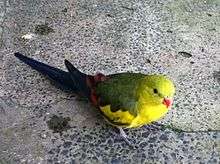Regent parrot
| Regent parrot | |
|---|---|
 | |
| A female (left) and male (right) in Wyperfeld National Park, Australia | |
| Scientific classification | |
| Kingdom: | Animalia |
| Phylum: | Chordata |
| Class: | Aves |
| Order: | Psittaciformes |
| Superfamily: | Psittacoidea |
| Family: | Psittaculidae |
| Subfamily: | Psittaculinae |
| Tribe: | Polytelini |
| Genus: | Polytelis |
| Species: | P. anthopeplus |
| Binomial name | |
| Polytelis anthopeplus (Lear, 1831) | |
| subspecies | |
|
P. a. anthopeplus | |
The regent parrot or rock pebbler (Polytelis anthopeplus) is a bird of the parrot family (Psittacidae). It has predominantly yellow plumage with a green tail. The bird is found primarily in eucalyptus groves and other wooded areas of subtropical southwestern Australia, as well as in a smaller area of subtropical and temperate southeastern Australia. Seeds make up the bulk of its diet. Regent parrots are popular in captivity.
Taxonomy
The regent parrot was first described by English author and wit Edward Lear in 1831. It is one of three species in the genus Polytelis. The parrot is also known variously as the rock pebbler, rock peplar, black-tailed parakeet, Murray smoker, Marlock parakeet and sometimes regent parakeet.
Two subspecies are recognised. While the western subspecies (Polytelis anthopeplus anthopeplus) is listed as "lower risk" or "least concern", the eastern subspecies (Polytelis anthopeplus monarchoides) is listed as endangered.
Three state governments and the federal government are coordinating a recovery plan for the subspecies.[2]
Description
The regent parrot grows to approximately 14½–16½" (37–42 cm) in length, and exhibits sexual dimorphism. The male bird is generally yellow, with several shades on the head; its back is generally a collection of colorful shades of green; its beak generally red. The female is generally more green, overall, especially in the head and body. The tail is green, although the underparts are black.
Behaviour
Diet
Captive regent parrots thrive on chopped mixtures for large parrots. They also like eggfood, fruit, sprouting seeds and a small assortment of insects. Unlike most birds parrots do not require grit in their diet, grit should only be given when a certified avian veterinarian prescribes it for digestion aid if the bird is ill. An occasional fresh willow or fruit tree branch to "spruce up" their quarters seems to please the birds.[3] The regent parrot is naturally hardy, so being careful to protect them from drafts and the like is unnecessary. However, they should be protected from excessive cold, as such is uncommon in their natural habitat.
Reproduction


The female broods 3-8 eggs for approximately 21 days. During this period she seldom departs from the nest, if at all, and is fed by the male. When the young have hatched, they are cared for by both the male and female. During this period, they can be fed several times their normal portion of feed, which they readily convey to their young. The young begin to fly at about 5 weeks. Sexual maturity is reached at about 2 years of age.
See also
- List of parrots (listed by taxonomic position)
- List of parrots (listed by name)
- List of Western Australian birds
References
- ↑ BirdLife International (2012). "Polytelis anthopeplus". IUCN Red List of Threatened Species. Version 2013.2. International Union for Conservation of Nature. Retrieved 26 November 2013.
- ↑
- ↑ "BeautyOfBirds - Regent Parrot Eastern Subspecies".
External links
| Wikimedia Commons has media related to Polytelis anthopeplus. |
